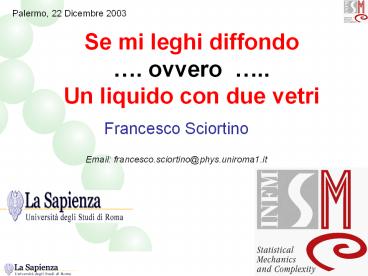Titolo ! - PowerPoint PPT Presentation
1 / 37
Title:
Titolo !
Description:
... due faccie della stessa fisica? ... Explanation of the cage and analysis of correlation function Rattling nella gabbia Dinamica delle gabbie log(t) Fq(t) ... – PowerPoint PPT presentation
Number of Views:73
Avg rating:3.0/5.0
Title: Titolo !
1
Titolo !
Palermo, 22 Dicembre 2003
Se mi leghi diffondo. ovvero ..Un liquido
con due vetri
Francesco Sciortino Email francesco.sciortino_at_p
hys.uniroma1.it
2
collaboratori
Ricerca sviluppata in collaborazione con
.. Giuseppe Foffi Piero Tartaglia Emanuela
Zaccarelli Wolfgang Goetze, Mattias Sperl,
Thomas Voigtmann
3
riassunto
- Schema del seminario
- Sfere dure, un modello per particelle colloidali
- Colloidi con corto range di interazione (SR)
- un nuovo asse nello spazio delle fasi e una
nuova lunghezza di localizzazione - Predizioni della teoria di accoppiamento tra I
modi (MCT) per colloidi SR
Simulazioni
Esperimenti - La Dinamica vicino il punto A4
- Domande Aperte
- vetri e gels due faccie della stessa fisica?
4
HS
Sfere Dure
Potenziale
(No temperatura, solo densita)
V(r)
r
s
Sperimentalmente, a f0.58, la dinamica si
arresta. La struttura del solido e disordinata
MCT transition ?51.6
- W. van Megen and P.N. Pusey Phys. Rev. A 43, 5429
(1991) - U. Bengtzelius et al. J. Phys. C 17, 5915 (1984)
- W. van Megen and S.M. Underwood Phys. Rev. Lett.
70, 2766 (1993)
5
HS e MCT
f(t)
HS (slow) dynamics
van Megen and S.M. Underwood Phys. Rev. Lett. 70,
2766 (1993)
6
Explanation of the cage and analysis of
correlation function
Leffetto gabbia (in Sfere Dure).
Fq(t)
Rattling nella gabbia
fq
Dinamica delle gabbie
log(t)
7
Giuseppe e Thomas
MCT --- confronto simulazioni/teoria per miscela
binaria HS
sA1 sB0.6
Foffi et al Prl 2003
8
The MSD in HS
Lo spostamento quadratico medio (nel vetro)
MSD
(0.1 s)2
log(t)
log(t)
9
What if .
Can the localization length be controlled in a
different way ?
What if we add a short-range attraction ?
Square-Well short range attractive Potential
Hard Spheres Potential
s
e
s D
lowering T
T gtgt e
T ltlt e
Attractive Glass
10
Figure 1 di Natmat
A model with two different localization length
Mean squared displacement
repulsive
attractive
(0.1 s)2
D2
Log(t)
How does the system change from one (glass) to
the other ?
11
Vari delta
MCT IDEAL GLASS LINES (PY) - SQUARE WELL MODEL -
CHANGING D
V(r)
D
A3
A4
PRE-63-011401-2001
Role of the width
12
The MCT predictions for short-range attractive
square well
MCT predictions for short range attractive
square-well
hard-sphere glass (repulsive)
Type B
s D
fluid
A3
Controlled by D/s
Short-range attractive glass
Fabbian et al PRE R1347 (1999) Bergenholtz and
Fuchs, PRE 59 5708 (1999)
Fluid-Glass on cooling and heating !!
13
Non ergodicity parameters for the two glasses
MCT Predictions Wavevector dependence of the
non ergodicity parameter (plateau) along the
glass line
Fabbian et al PRE R1347 (1999) Bergenholtz and
Fuchs, PRE 59 5708 (1999)
14
Isodiffusivity
Confronto con le simulazioni. Curve
iso-diffusivita
Zaccarelli et al PRE 2002
15
Correlatori lungo la linea
Simulazioni Funzioni di correlazione della
densitalungo una curva di iso-diffusivita
Bassa T (attrattivo)
Alta T (repulsivo)
16
R2 lungo la linea
Simulazioni Spostamento quadratico medio lungo
curva isocrona
Sub diffusive !
(0.1 s)2
D2
17
Non-ergodicity factor
Simulazioni Parametro di non ergodicita lungo
curva isocrona
Vetro attrattivo
Vetro repulsivo
18
Funzioni di correlazione
19
Depletion Interactions Cartoons
Depletion Interaction A Cartoon
20
Science Pham et al Fig 1
Fluid-glass line from experiemnts
Glass samples
Fluid samples
Temperature
MCT fluid-glass line
21
(No Transcript)
22
(No Transcript)
23
Bartsh PRL (no polymer-with molymer)
HS (increasing f)
Adding short-range attraction
T. Eckert and E. Bartsch
T. Eckert and E. Bartsch
Colloidal-Polymer Mixture with Re-entrant Glass
Transition in a Depletion Interactions
Phys.Rev. Lett. 89 125701 (2002)
24
Barsh PRL (phi effect)
Temperature
25
Tracing the A4 point Theory and Simulation
PY
PY transformation
fMD 1.897fPY-0.3922 TMD 0.5882TPY - 0.225
FS et al, cond-mat/0304192
PY-MCT overestimates ideal attractive glass T by
a factor of 2
Tracing the A4 point
26
Isodiffusivity curves (MD Binary Hard
Spheres)
Zaccarelli et al PRE 66, 041402 (2002).
Isodiffusivity
27
Same T and f, different D
Fq(t)fq-hq B(1) ln(t/t) B(2)q ln2(t/t).
Phi(t)
28
MSD logaritmico
5 decadi di genuino comportamento sub-diffusivo !
29
Figura 2 di natmat
Un Riassunto (ed i problemi aperti) !
Linea Vetrosa
Vetro Repulsivo
Liquido
Stabilizzazione dello stato liquido, dinamica
logaritmica
Concentrazione di polimero (Non-adsorbing)
Temperatura
?
Transizione Vetro-vetro
Vetro attrattivo
Processi Attivati?
Gel
Frazione di Volume
30
Phase Diagram for Square Well (3)
Iso-diffusivity lines
Spinodal AHS (MillerFrenkel)
Repulsive Glass
Percolation Line
Percolation Line
A3
Attractive Glass
Spinodal
LiquidGas
31
(No Transcript)
32
Grazie.
Acknowledgments
Marilena
Carolina
Alfredo
33
Equazioni base della MCT
Equazioni MCT !
34
aging
Un salto nel vetro
35
Glass glass
Transizione Vetro-Vetro e processi attivati
Basse T
Alte T
36
Bond No-bond
e
s D
37
BMLJ
SiO2
MCT fq































